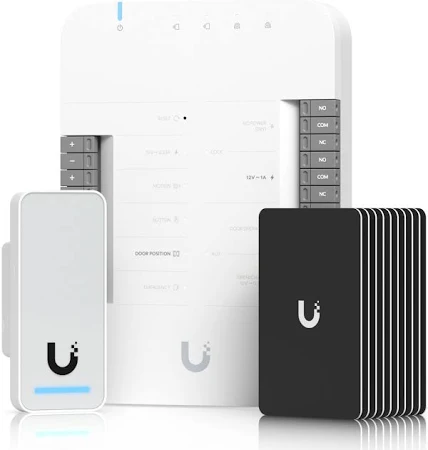Ubiquiti Door Access Solutions in IT Hardware Systems
Security has always been a cornerstone of effective IT and business infrastructure. As data becomes more valuable and threats more...

Security has always been a cornerstone of effective IT and business infrastructure. As data becomes more valuable and threats more sophisticated, physical access control is now just as important as cybersecurity. Enter Ubiquiti Door Access—a powerful and scalable solution designed to protect assets, data centers, and restricted areas. Known for its innovative networking and IT solutions, Ubiquiti has extended its capabilities to smart access systems that align with modern IT hardware and computer hardware demands.
What is Ubiquiti Door Access?
Ubiquiti Door Access, often part of the UniFi Access ecosystem, is a suite of hardware and software solutions developed to secure entry points. The system enables centralized access control, user management, entry logging, and door hardware integration—all in one sleek, network-managed solution.
The suite typically includes:
- UniFi Access Controller (UA-Hub)
- UniFi Access Reader (UA-Reader Pro, UA-Card Reader)
- UniFi Access Cards and Key Fobs
- UniFi Access Software
These components provide a complete access control system that integrates seamlessly into Ubiquiti’s broader network infrastructure.
Why Access Control is Critical for IT Hardware Environments
In data-sensitive industries, securing computer hardware is as vital as protecting the data itself. Servers, switches, and backup devices must be housed in secure locations with limited access.
Access control helps:
- Prevent unauthorized entry
- Protect sensitive IT hardware from tampering
- Monitor user access logs
- Comply with regulations like HIPAA, GDPR, and PCI-DSS
By using Ubiquiti Door Access, organizations not only manage digital network security but also ensure that the physical environment of computer hardware remains tamper-proof.
Key Features of Ubiquiti Door Access
1. Centralized Management via UniFi
All Ubiquiti Door Access devices can be managed through the UniFi Controller, providing a unified dashboard for all access logs, user credentials, device statuses, and real-time alerts. This cloud-managed system allows both on-site and remote monitoring—ideal for businesses with distributed facilities.
2. User-Based Permissions
Administrators can assign different levels of access to employees based on roles, departments, or shifts. This granular control ensures that only authorized personnel can interact with designated computer hardware or network infrastructure.
3. Smart Access via NFC and Mobile
Ubiquiti supports keycards, key fobs, and mobile-based access via NFC. This reduces dependency on traditional keys, enhances security, and allows for faster onboarding and revocation of access.
4. Real-Time Logging and Alerts
Security administrators can receive instant notifications when a door is accessed, forced open, or remains unlocked for too long. This feature helps protect IT hardware environments where security breaches could lead to catastrophic data loss.
5. Integration with Video Surveillance
Ubiquiti’s ecosystem allows integration between Door Access systems and UniFi Protect, providing video footage linked directly to access events—strengthening oversight over sensitive areas.
Architecture of Ubiquiti Door Access Systems
A Ubiquiti Door Access setup typically includes:
- UA-Hub: The central controller that communicates with all readers and locks.
- UA-Readers: Devices mounted at entry points to read access cards or mobile credentials.
- Electronic Locks: Can be wired to doors and controlled via the UA-Hub.
- Power over Ethernet (PoE): All devices receive power and data over a single Ethernet connection, reducing cabling complexity.
This modular architecture allows scalability and easy integration into new or existing IT hardware infrastructures.
Integration with IT and Computer Hardware Ecosystems
Compatible with Existing Network Devices
Ubiquiti Door Access hardware connects to standard Ethernet networks and is compatible with existing switches, routers, and PoE injectors. This makes it easier for organizations already using Ubiquiti IT hardware to expand their security setup without costly overhauls.
Works with Directory Services
For businesses managing access centrally through Active Directory or LDAP, the UniFi Access Controller supports synchronization—making it part of your identity and access management ecosystem.
Seamless Updates
Ubiquiti frequently rolls out firmware and software updates to patch vulnerabilities and add new features. These updates ensure that your access control system keeps pace with evolving security requirements.
Use Cases of Ubiquiti Door Access in IT Environments
1. Data Centers and Server Rooms
Restricting physical access to data servers is essential for maintaining security compliance. With Ubiquiti Door Access, IT managers can control who accesses the server room, log every entry/exit, and monitor conditions remotely.
2. Office Entry Points
Secure main entrances and employee-only zones using Ubiquiti’s NFC readers. Administrators can easily revoke access for former employees or assign temporary credentials for contractors.
3. Campus Environments
In universities and corporate campuses, Ubiquiti Door Access offers a scalable way to manage multiple buildings and access points from a centralized dashboard.
4. Warehouses and Manufacturing Plants
Ubiquiti systems can be used to secure areas housing expensive computer hardware and inventory. Shift-based access control and video integration ensure accountability at every level.
Installation and Configuration
Setting up a Ubiquiti Door Access system involves several steps:
- Planning Entry Points: Identify which doors will be controlled and how (e.g., card access, mobile, or pin pad).
- Mounting Hardware: Install UA-Hub near the entry point and UA-Readers on doors.
- Connecting PoE Switches: Use PoE-capable switches to power and connect devices.
- Configuring via UniFi Access: Use the web interface to enroll users, set permissions, and link doors with specific hardware.
- Testing and Auditing: Confirm operation, test card readers, and review event logs for accuracy.
No specialized knowledge is needed, which makes it an excellent choice for small IT teams managing extensive computer hardware environments.
Security Advantages Over Traditional Systems
- Encryption: All communications are encrypted, ensuring data integrity and protection.
- Remote Access Management: Unlike legacy systems, Ubiquiti enables control from anywhere.
- Quick Credential Revocation: Lost or stolen cards can be deactivated instantly.
- Scalable: From single-door setups to enterprise-wide deployments.
These benefits make Ubiquiti ideal for modern IT hardware and computer hardware infrastructures where physical access equals digital vulnerability.
Compliance and Regulatory Alignment
Organizations are under increasing pressure to meet data security regulations. Physical access control is often a required component of:
- HIPAA (for healthcare organizations)
- PCI-DSS (for financial and payment processing institutions)
- SOC 2 (for service organizations)
- ISO/IEC 27001 (for information security management)
Using Ubiquiti Door Access helps businesses align with these frameworks by providing:
- Access logs for audit trails
- Multi-factor physical verification
- Role-based access control
- Integrated security systems
Comparing Ubiquiti with Other Access Control Solutions
| Feature | Ubiquiti Door Access | Legacy Systems | Cloud-Only Systems |
|---|---|---|---|
| Centralized Management | ✅ | ❌ | ✅ |
| PoE Integration | ✅ | ❌ | ✅ |
| Software Updates | ✅ | ❌ | ✅ |
| Camera Integration | ✅ | ❌ | ❌ |
| Cost-Effective | ✅ | ❌ | ❌ |
| Ecosystem Compatibility | ✅ | ❌ | ❌ |
Ubiquiti stands out for providing enterprise-grade features at SMB-friendly pricing.
Best Practices for Maximizing Ubiquiti Door Access
- Use Multi-Factor Access: Combine card + mobile app to reduce spoofing risks.
- Regularly Review Access Logs: Look for anomalies and irregularities.
- Update Firmware Frequently: Patch security vulnerabilities on time.
- Segment Entry Levels: Use access levels for departments, shifts, and roles.
- Integrate with Cameras: Pair with UniFi Protect for video validation of access events.
Following these tips ensures optimal use of your Ubiquiti Door Access system across your IT hardware environment.
Common Issues and Troubleshooting
- Reader Not Responding: Check PoE switch and cable integrity.
- Access Denied for Valid User: Reverify permission settings in UniFi Access.
- Unrecognized Device: Ensure device is adopted and visible in the controller.
- System Lag or Freeze: Update to the latest firmware and controller version.
Ubiquiti’s support forums and knowledge base offer fast resolutions, backed by a strong user community.
Future of Ubiquiti Door Access
As workspaces become increasingly hybrid and decentralized, Ubiquiti Door Access is poised for further innovation. Anticipated features include:
- Biometric integration
- AI-powered behavioral analysis
- Automated threat detection
- Deeper cloud-service tie-ins for compliance and logging
These upgrades will make the system even more valuable to professionals managing large-scale computer hardware networks and facilities.
Conclusion:
Ubiquiti Door Access offers a cost-effective, scalable, and reliable solution for physical access control in IT-heavy environments. By integrating seamlessly with existing IT hardware and computer hardware systems, it ensures that organizations stay protected not just in cyberspace, but also at the physical level.
Whether managing a server room, securing corporate offices, or regulating warehouse access, Ubiquiti delivers the tools and intelligence to safeguard your assets. With its plug-and-play architecture, centralized management, and robust ecosystem, Ubiquiti Door Access isn’t just another access control system—it’s a smart investment in the future of IT security.

